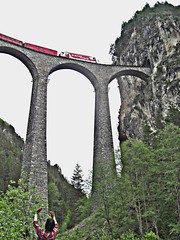Choo! Choo! Fighting on Trains in RPGs
published
As Darths & Droids said this morning:
It’s important to have an appropriate setting for the big fight scenes in your games. The top of a speeding train. A rickety rope bridge over an incredibly deep gorge with a crocodile infested river below. The enormous arch-villain’s lair inside an extinct volcano, complete with piranha pit. (About the only thing that could make that one better is to use an active volcano, really.)
I’ve run a game with a fight on top of a train (which, sadly, didn’t go too well as I was still getting comfortable with the system) and I’ve played a game with a fight inside a train (which was awesome, especially when a Shatter spell derailed the carriage). Neither of them used a tunnel. Tunnels are great, they give you the classic “Oh no! I have to duck down or cling to the side of the train or be hit by a mountain!” situation. So, in preparation for the next time I run a simulationist game I can fit a train in to (sadly my current plotting revolves around ancient Rome) let’s do some research and some maths.
I’m looking at Fantasy Craft for this, it is a 3.5 derivative so I’ll convert everything to 5′ squares by the time we’re done. You should be able to adapt this for whatever system you like though.
First stop, Wikipedia:
The all-time speed record for steam trains is held by an LNER Class A4 4-6-2 Pacific locomotive of the LNER in the United Kingdom, number 4468 Mallard, which pulling six carriages (plus a dynamometer car) reached 126 mph (203 km/h) on a slight downhill gradient down Stoke Bank on 3 July 1938.
Now that’s fast! However, it probably doesn’t account for having to slow down for bends and it doesn’t say how full the carriages are of passengers and/or cargo (and there are only 6 of them). My modern commuter train probably never goes above 70mph (through hilly Kentish countryside).
Still, have now have some baseline figures for speed, how about length?
First Great Western have some statistics about their fleet. Carriages range from about 15 meters to a little over 23 meters. That’s about 50′ to 75′ or 10 to 15 squares.
Back to the speed. If we say 50mph, then that is about 75’/sec. That’s 6 carriages per round (15 carriages if we take the world steam locomotive speed record!). That is a bit faster then I’d like as it prevents me from having the tunnel mouth move up the battlemat for a few rounds to give a sense of impending doom. So, back to history…
The small locomotives of the 1830s, pulling a handful of cars over uneven track, could travel at fifteen to twenty miles an hour. This was twice as fast, over long distances, as anything Americans had previously experienced.
15-20mph is 22’/sec to 29’/sec or 24-36 squares per round. It should be possible to select a speed in that range that will give you two carriages a round for most carriage sizes, and that is quick enough to be a worry but slow enough to avoid the tunnel crossing your tabletop in just one or two rounds.
You can let the train roll initiative or just have it more at the start or end of each round.
 Obviously, falling off a train at 15mph is a lot less of a worry then falling off at 20mph, but being left behind could cost a player character their mission … and the GM could always make the train cross a bridge before entering the tunnel.
Obviously, falling off a train at 15mph is a lot less of a worry then falling off at 20mph, but being left behind could cost a player character their mission … and the GM could always make the train cross a bridge before entering the tunnel.
And finally, a few useful rules to use for this situation. Page numbers are for Fantasy Craft 2nd printing.
For the basic “Fight on a train” situation, you can demand Balance checks (page 69). The surface will be up to 30 degrees but shaking, and the characters will often be attacked.
When the tunnel approaches characters will have a few options:
Diving to lay flat on top of the train is a simple Reposition (page 219) action to become prone.
Jumping into the gap between carriages is an Acrobatics check (page 69). I’d call this a Balance check, for a Narrow Walkway (5-8″ wide) with the usual modifier for a buckled, rolling, sagging, or shaking surface.
Climbing (page 70) from the top of the train onto the side (or the other way) will have a base DC of 10 (Common hand- and footholds/opportunities to brace) or 5 (if they use a ladder). If things are going too easily for the players, you could add a situational modifier for doing this on a speeding train.
Don’t forgot the penalty for being attacked in the current or previous round for those last two checks!
If the fight is going too too well or too badly, then the train can change speed or NPC balance etc checks can be fudged.
One day I’ll run my Steampunk Three Musketeers game and will dig these plans out to test them.
If you’ve tried these suggestions, have alternative approaches, or spotted a flaw in my maths (which I shall blame on the stupid hour of the morning that I’m writing this in) then the comments will be open for a while.
Choo! Choo!
Image by Brian Rosen and used under a Creative Commons license